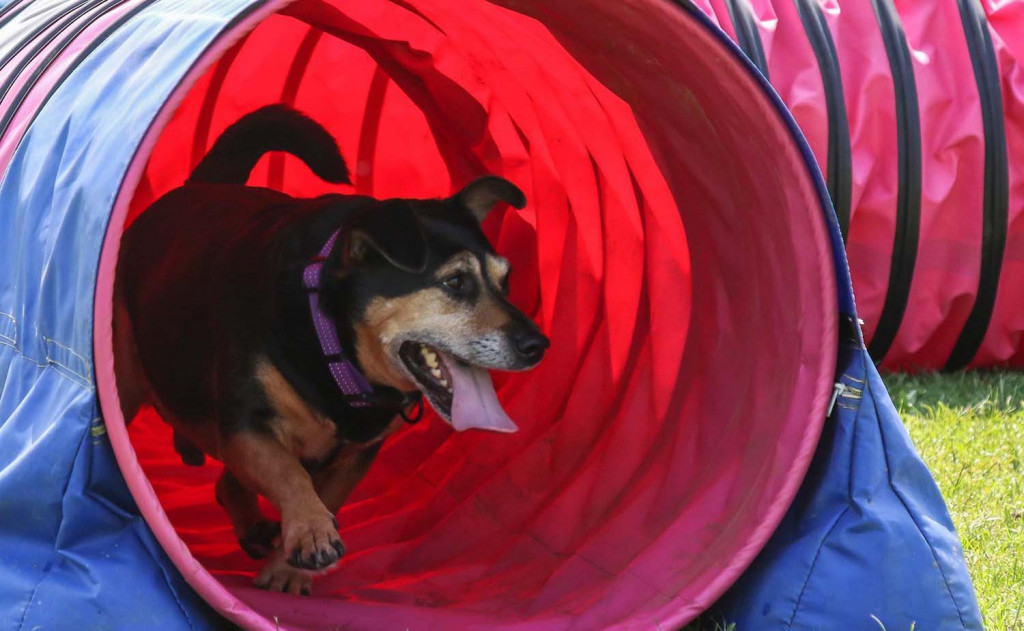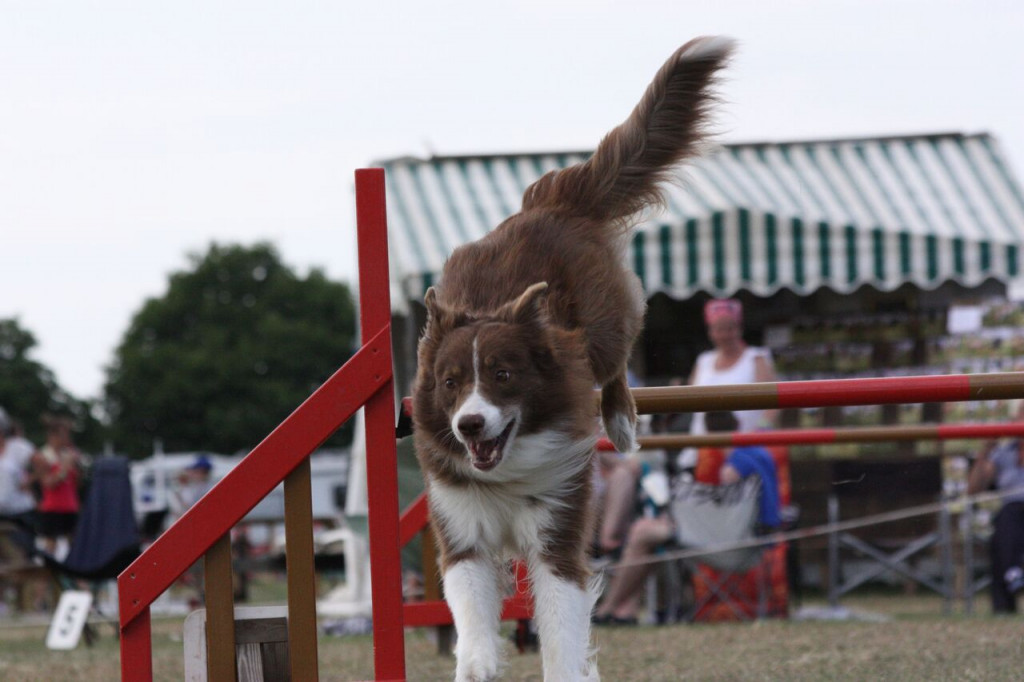The Importance of Learning Foundation Skills in Dog Agility Training - Part 1

Reading time – 6 mins
This is Part 1 of a 3-part series – an in-depth look at the importance foundation skills play when you begin your dog agility training journey.
You can read Part 2 here.
Dog agility is a vibrant and engaging sport where dogs navigate through a course of obstacles under the guidance of their handler.
It's not just about speed. Agility tests a dog's fitness, obedience and the teamwork between dog and handler.
Agility offers your dog a varied and exciting challenge, from weaving through poles to jumping over hurdles and darting through tunnels.
To succeed in dog agility, you need to master foundation skills, as they lay the groundwork for your dog's success in the sport.
This introduction to agility training highlights the importance of starting with these basic skills, ensuring a fun and safe experience for dogs and their handlers.
The Importance of Foundation Skills
Whether you are interested in competition or agility training for fun, the key to success lies in learning and mastering fundamental skills. Every dog agility journey begins with understanding these basics, which will enhance your dog’s confidence, performance, and overall well-being.
Foundation skills are not just about achieving speed on the course but also about avoiding injuries.
The Building Blocks of Agility Training
The Building Blocks of Agility Training
The Basics – Core Foundation Skills
The Basics – Core Foundation Skills
- Effective communication helps to build trust and a solid partnership.
- Key commands like recall and stay are essential.
- Agility-specific skills include jumping, weaving, and handling contact obstacles like the A-frame.
- Developing your dog's body awareness ensures precise navigation around the course.
- Positive reinforcement by handlers plays a crucial role in motivating and shaping these skills, setting the stage for successful agility teamwork.
Communication and Cues
Communication and Cues
Dogs are natural at picking up body language and use it to understand humans and other dogs. They're also smart in figuring out what different sounds mean. So, when you're running through an agility course with your dog, using a mix of visual and verbal cues will help guide them.
When teaching your dog new agility moves, it's not just about the move itself. It's about teaching them a sign or a word that tells them, "Hey, it's time to do that thing we practiced."
This is where cues come in. Connecting specific signals with actions creates a unique way of communicating with your dog. Getting this right is like having a chat with them.
Clear communication is key in any strong relationship, including the one with your dog. By building this unique way of talking to each other, you improve at agility and strengthen your bond with your dog. This special communication is a big part of what makes working together so rewarding.
Body Awareness and Control
Body Awareness and Control
Pre-jump training is essential to prepare your dog for what's ahead. This early stage helps them grasp the basics of jumping, which is more than just leaping over obstacles.
Body awareness and control are important. Even though dogs are naturally well-balanced for day-to-day activities, overcoming agility obstacles is different. They require a specific jumping technique that’s not just about clearing the obstacle but also about doing so safely and keeping your dog injury-free.
Confidence and Trust-Building
Confidence and Trust-Building
Building trust and confidence between you and your dog is essential for a great partnership in dog agility. Your dog needs to see you as a reliable leader and know that following your lead is safe.
Your instructions should lead to success. This success is like their reward, showing them they're on the right track.
Dogs are like us in many ways; they like things that make them feel good and avoid what doesn't. If training causes them pain, makes them uncomfortable, or scares them, they will start to lose trust in you.
By teaching them clearly and celebrating their successes, they will understand what you're asking for, and their confidence and trust in you will follow.
As they get better, they'll be able to handle more complex tasks, like working with distractions or from a distance.

Why Foundation Skills Matter
Why Foundation Skills Matter
Safety First: Preventing Injuries on the Course
Safety First: Preventing Injuries on the Course
In dog agility training, safety trumps everything. Basic skills are crucial in safeguarding your dog and preventing injuries. Each leap and move demands careful execution and an understanding of safe movement.
Mastery of obstacles is key to avoiding mishaps. Even slight errors can be harmful. For success and safety in training, dogs must master swift, precise movements.
Building on the basics is essential for advanced techniques, which rely on speed, balance and agility. Skipping foundational training risks accidents. Knowing the obstacles inside out will ensure you and your dog enjoy a safe agility training journey.
Building A Solid Partnership: The Key to Agility Success
Building A Solid Partnership: The Key to Agility Success
Agility training can strengthen your relationship with your dog, and a solid bond is key to success. It's important to pay attention to how you interact with your dog. Every interaction can either help or hurt your bond, especially if it's a bad experience.
So, it's crucial to focus on the positive aspects of your dog's behaviour. Always look for opportunities to praise and reward them for doing well.
Regular training sessions are a great way to celebrate your dog's hard work and success. Start with simple training exercises that allow for lots of rewards. This builds their confidence and motivation and makes them more excited to work with you.
You'll build a strong and lasting bond by creating a supportive and rewarding training atmosphere.
Enhancing Learning Efficiency: Easier Progression to Advanced Techniques
Enhancing Learning Efficiency: Easier Progression to Advanced Techniques
There are a couple of key strategies you can use to make your dog's learning easier and help it progress to more complex skills.
First, always have your dog's rewards ready. There's a saying that goes, “If you can clicker train a chicken, you can train a dog.” This highlights how important it is to give rewards at the right time.
If you wait too long, you might accidentally reward the wrong behaviour. For example, if you teach your dog to sit but give the treat when they stand up to get it, they might think standing is what you want them to do.
Next, think about where you're training. Starting in a familiar place like your home, with fewer distractions, can help your dog concentrate and remember better.
Keeping your dog calm is also important. Too much stress or excitement can make it hard for them to learn because it triggers their instinct to either run away or react. Stress or being too excited can also make your dog less interested in treats or rewards.
By giving rewards quickly, training in the right environment, and keeping your dog emotionally steady, you can boost their learning and make it easier for them to pick up advanced skills.
Sian's Top Tip
Sian's Top Tip
Timing is important when a marker word indicates a reward is coming. So, it is a good idea to practise saying your marker word so that you can use it quickly as a reactive response to your dog’s behaviour.
In my early days of learning how to train dogs, I would bounce a tennis ball (without my dogs present), and the moment the ball connected with the floor, I would say my marker word, "Yes".
Repetition is the only way to master saying it quickly and without thought. Setting aside one minute per day for a couple of weeks will strengthen the connections inside your brain, allowing for faster reaction times.
In Part 2, we'll examine how patience and consistency can help you in your training journey. We'll also cover some key foundation exercises and examine common challenges and how to overcome them.

